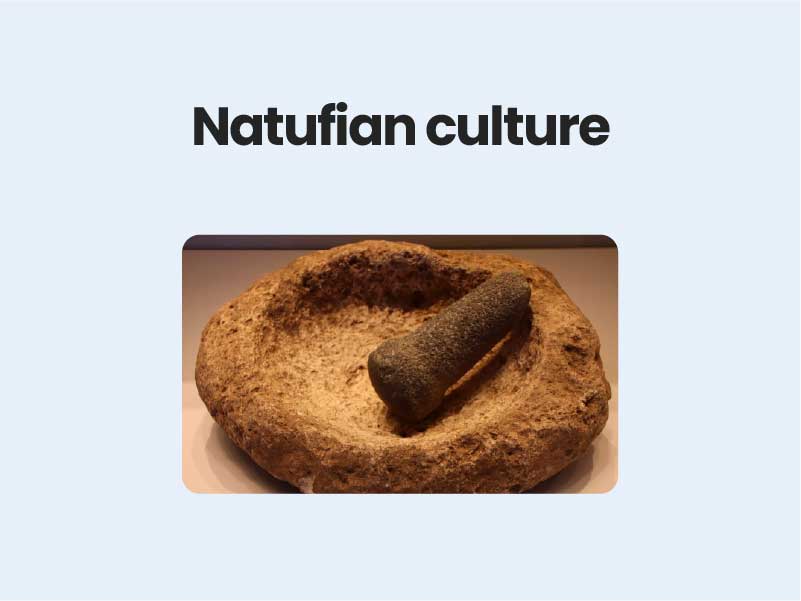Companion@360 → 7 Month programme to sharpen your writing skills → REGISTER NOW

Natufian culture
Mesolithic culture of Palestine and southern Syria dating from about 9000 BC. Mainly hunters, the Natufians supplemented their diet by gathering wild grain; they likely did not cultivate it. They had sickles of flint blades set in straight bone handles for harvesting grain and stone mortars and pestles for grinding it. Some groups lived in caves, others occupied incipient villages. They buried their dead with their personal ornaments in cemeteries. Carved bone and stone artwork have been found.
Natufian culture:
- The Natufian culture was first identified by Garrod (1932) during excavation of Shukbah Cave in Samaria and el-Wad at Mt Carmel. Since the 1930s, many Natufiansites have been reported from the Mediterranean Hills, the Jordan Valley, the Negev desert, and the Jordanian Plateau .
- The Natufian is an Epipalaeolithic industry for which the lunate, the most abundant geometric flint microlith, serves as an important chronological marker.
- The Natufian has traditionally been divided into Early and Late phases at 13,000 cal BP based on differences in burial customs (decorated early Natufian burials), the richness of art and ornament assemblages, the size of built structures, and, most importantly, the average greatest length of the lunate and the type of retouch employed in its manufacture
NATUFIAN SITES:
- Late Natufian sites are geographically widespread. In some areas, sites are more or less sedentary, while in others, adaptations are more mobile and seasonal, depending on environmental conditions.
- Several caves and rockshelters inhabited during the Upper Palaeolithic, but abandoned in the Early Epipalaeolithic periods, were reoccupied during the Early Natufian.
- Many new sites were established during the Late Natufian, and continued to be used in the succeeding Pre-Pottery Neolithic .
- Natufian sites with large structures indicating the sedentary or semisedentary habitation of large groups in the final stages of the Late Natufian culture in the Jordan Valley.
- Based on distinct features of Natufian sites such as permanent architecture and microfaunal remains, including the first commensal species (domestic mice, rats, and the sparrow), Tchernov suggested that sedentary settlements, (residentially stationary arround occupations), emerge in the Natufian.
SUBSISTENCE PRACTICES:
- The Mediterranean southern Levant was rich in food plants, including cereals, pulses, and nuts. Unfortunately, botanical evidence from Natufian sites is scarce, owing to poor preservation.
- Although the Natufians continued the Epipalaeolithic tradition of nut consumption evidence from phytoliths, groundstones, and sickle blades indicates that reliance on large-grained grasses increased significantly during this period.
- Although dog domestication is purported to have taken place by the Natufian, based on the discovery of joint canid–human burials at Eynan and Hayonim Terrace.
- The Natufians used a variety of technologies including nets, traps and bows and arrows to capture a wide spectrum of large and small wild animal taxa. Large prey included aurochs, red deer, fallow deer, and wild boar, but the small-bodied mountain gazelle was the staple species.
- Small game including slow-moving tortoises as well as quicker species such as hares, groundbirds, waterfowl, and fish were routinely collected throughout the Natufian.
ARCHITECTURE:
- Increases in the scale of the built environment had a significant impact on Natufianlandscapes. Architecture includes rounded pit houses, with foundations made of local, undressed stones and retaining walls supporting the perimeter of the structure.
- Although semi-subterranean structures first appear in the region during the Early Epipalaeolithic.
Read Also Gupta Empire
BURIALS:
- The Natufian presents a striking increase in the number of human burials and in the size and scale of cemeteries. This is exemplified at the Late Natufian sites of Hilazon Tachtit and Raqefet Cave, which functioned nearly exclusively as cemeteries.
- A rise in the percentage of secondary burials, combined with skull removal and subsequent reburial in new locations, sometimes with other crania, first emerges in the Late Natufian and continues into the Neolithic Period
- The appearance of specialized funerary sites and associated feasting and other ritual practices indicates increased visibility of ritual practice in the Natufian.
ARTISTIC EXPRESSION:
- Larger numbers of personal ornaments are recovered from Natufian sites than any preceding context. For example, 25% of the 1,000 worked bone items from the Natufian layer at Hayonim Cave were personal ornaments, including pendants and beads made of animal bone and teeth.
- Finely shaped, oval bone pendants manufactured from gazelle metapodials and perforated at the narrow end have been recovered from several Natufian sites. Most of the pendants were recovered from burials.
Natufian culture Groundstone Tools:
- Groundstone tools are rare prior to the Natufian, but are common in Natufian base camps they comprise mortars of various sizes and a variety of bowls, mullers, and pestles made of limestone, basalt, and sandstone.
- These include very large fixed mortars, including boulder mortars, which weigh up to 100 kg and are 70–80 cm deep.
- Natufian boulder mortars retrieved from Mediterranean sites share specific traits that reflect common practices related to Natufian burial and commemorative
Read Also Post Maurya Era
SOCIAL ORGANIZATION AND RITUAL PRACTICE:
- Human burial inclusions indicate that the Natufians were egalitarian and lacked differentiation by wealth argues that egalitarianism was maintained through burial practices that minimized special treatment to downplay social differences as a strategy to cope with huge social and economic changes.
- Many of the social and economic changes associated with the transition to agriculture began or at least intensified during the Natufian and undoubtedly entailed substantial ideological changes.
- In the material record, these are expressed in ritual practice associated with human burials, such as arrangements of burial inclusions and the consumption of large quantities of food.
- The increasingly public dimension of ritual practice suggested by these communal events implies a greater need for integrative mechanisms as the Natufians settled into more permanent communities.
The end of the Natufian and throughout the Pre-Pottery Neolithic A, various loci of incipient sedentism and cultivation formed in the Near East. In the southern Levant, the local Pre-Pottery Neolithic A culture emerged from the Natufian.
View this post on Instagram


